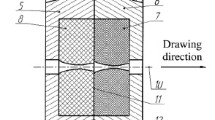Abstract
This article describes the experimental work carried out to investigate the feasibility of producing multilayered metallic strip by cold drawing. Two types of strip were prepared. The first was a bi- layered strip of aluminum/mild steel. The second type of strip was a tri- layered material made of aluminum/copper/aluminum layers. To examine the effects of process variables, the amount of deformation and the die angle were varied, and the drawing force and the strength of the interface bond were measured. The results of numerous experiments revealed that drawing stress increases almost linearly with an increase in relative reduction in area. Drawing stress also exhibits a minimum point when plotted versus die angle. It was observed that formation of an interfacial bond requires a minimum threshold value for reduction in area. Based on scanning electron microscopy observations, a mechanism for cold weld formation is explained.
Similar content being viewed by others
References
“Standard Test Method for Peel Resistance of Adhesives (T-Peel Test),” ASTM D1876-72 (Reapproved 1978), vol 22, ASTM, Philadelphia (1980).
New Development in a Cold Welding of Ductile Metals,Wire, 31 (5), 234-235, Sept/Oct (1981).
R.C. Pendrous, “The Cold Pressure Welding of Metals”, Ph.D. thesis, The University of Leeds, England (1980).
R.F. Tylcote, Investigation on Pressure Welding,Brit. Weld. J., 117–135(1954).
H. Kudo, K. Nakamura, M. Tsubouchi, and Y. Matsumoto, Proc. Conf. Advanced Technology of Plasticity, Yokohama National University (1987).
N. Bay, Cold Pressure Welding Process; Characteristics, Bonding Mechanisms and Surface Treatment Methods,Denmark Tekinske Hojskole, Srejsning, 15(1), 4–8, Jan (1988).
R. Clernik, Cold Welding of Al + Al and Al + Cu Conductors used in Power Distribution Systems,35(6), 185–188 (1986).
T. Nakamura and K. Kondo, Effect of Plastic Deformation and Temperature on Solid State Bonding,J. Jpn. Soc. Technol. Plast., 25(302), 1150–1157(1987).
A. Praks, Investigation and Practical Experience in Cold Pressure Welding with Displacement, Conf. Proc. JOM3 Int. Conf. of Metals, Latvian State University, Helsingor, Denmark, 19–22 (1986).
M.G. Nicholas and D.R. Milner, Roll Bonding of Aluminum,Brit. Weld. J., 9,469–475 (1962).
T. Tabata, S. Nasaki, and K. Azekura, Bond Criterion in Cold Pressure Welding of Aluminum,J. Jpn. Soc. Technol. Plast., 27(303), 521–525, Apr (1988).
D. Malamkovic, The Welding of Aluminum to Steel and Copper,Zis Mitt, 30(3), 269–275, Mar (1988).
I. Knap, Cold Pressure Welding when Joining Contact Wires,Wire World Int., 29(3), 63–65, May-Jun (1987).
Author information
Authors and Affiliations
Rights and permissions
About this article
Cite this article
Taheri, A.K., Majlessi, S.A. An investigation into the production of Bi- and Tri-layered strip by drawing through wedge-shaped dies. JMEP 1, 285–291 (1992). https://doi.org/10.1007/BF02648629
Issue Date:
DOI: https://doi.org/10.1007/BF02648629




